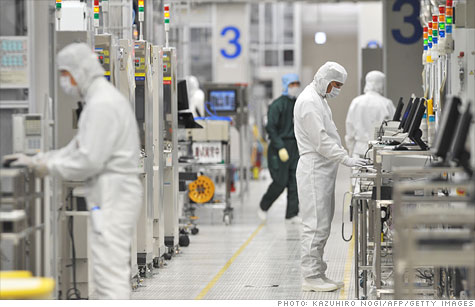Search News

Employees at a Japanese microprocessor maker were back at work in early June.
NEW YORK (CNNMoney) -- The violent earthquake, tsunami and nuclear disaster in Japan earlier this year severely rattled the technology industry's supply chain and pushed back the launch dates of several new devices. But an end is in sight: A new report predicts that the industry will be completely back up and running in about two months.
A study released Wednesday by IHS iSuppli said that electronics makers located nearest to the epicenter of the earthquake will be the last to get back online, but they are expected to make a full recovery by early September. That's a full six months after the earthquake first rocked northern Japan on March 11.
Japanese suppliers are responsible for 35% of the world's NAND Flash production, and Japan is the world's leading source of semiconductor and LCD manufacturing equipment. A total of 14 semiconductor suppliers and four silicon wafer makers in Japan were adversely impacted by the disaster, IHS iSuppli said.
Dallas-based Texas Instruments (TXN, Fortune 500), for instance, said it had suffered "substantial damage" to its production plant in Miho, Japan, located north of Tokyo -- right in the area most affected by the disaster. The Miho plant, which was responsible for about 10% of the company's output last year, was mostly offline until May, and it won't be fully operational until the middle of next month, the company said. But TI expects full shipment capabilities to be restored in September.
Global supply constraints have been exacerbated by rolling blackouts, which remain a problem in some areas. Many production facilities were unable to go back online until the aftershocks stopped, many weeks after the initial quake.
Many consumer electronics companies suffered from supply constraints. Apple (AAPL, Fortune 500) was able to scramble and find suppliers in other regions, but most others weren't as lucky.
Sony Ericsson, for instance, said it delayed its eagerly anticipated Xperia Play "PlayStation phone" because of the Japan earthquake's impact on the supply chain.
Research In Motion (RIMM) also delayed its PlayBook tablet by a month due to the lack of sufficient supplies.
Sony (SNE) expects the Japanese earthquake to cost the company upwards of $2 billion.
"In the history of the electronics supply chain, nothing has had such a broad impact," said Dale Ford, senior vice president for semiconductor market intelligence at IHS, in a statement.
But even the companies suffering the most direct damage from the quake will resume "near the end of the third quarter," he said.
The recovery's timing is particularly good news for the microchip industry. The full restoration of their business will coincide with the peak season for electronics and semiconductor sales, IHS iSuppli said.
As a result, the research group expects semiconductor sales to rise 7.4% from the end of the second quarter through the third quarter. Chip sales slumped 1.4% in the first quarter and are expected to grow just 2.9% in the current quarter. ![]()